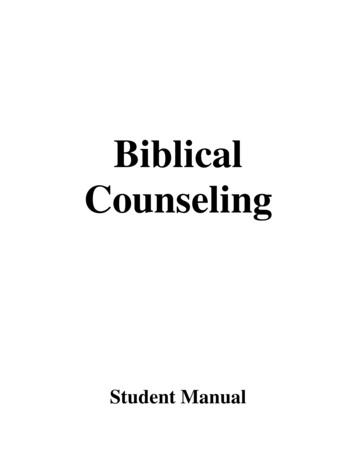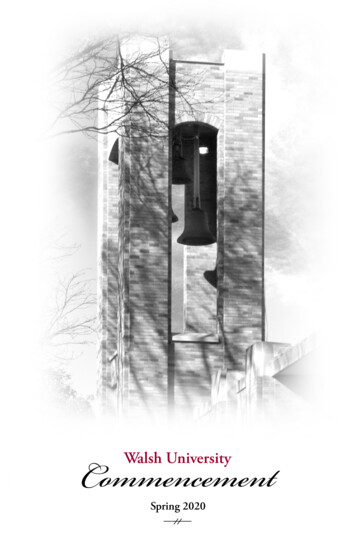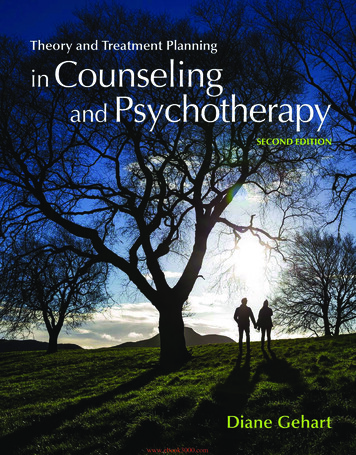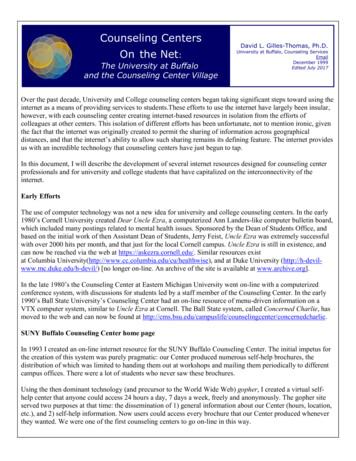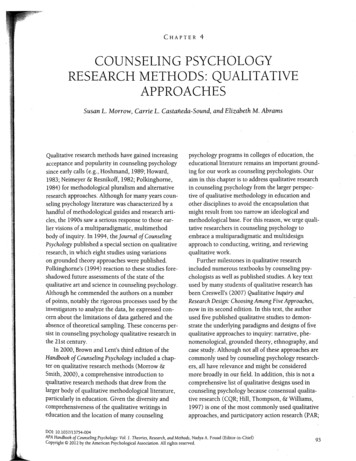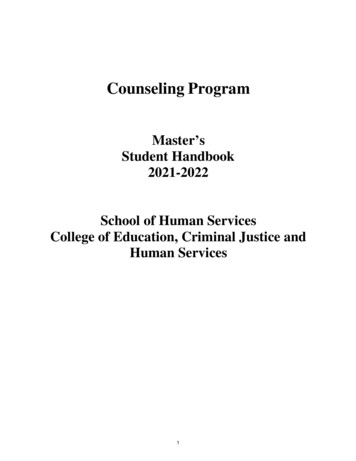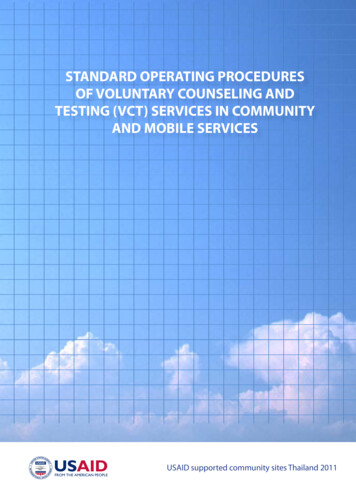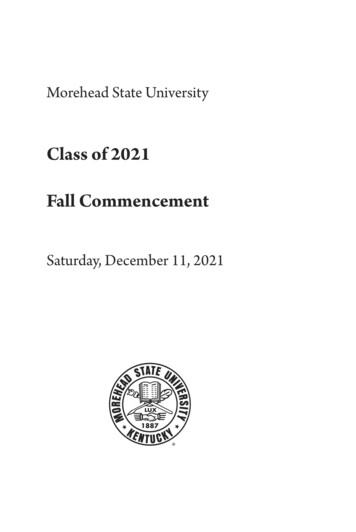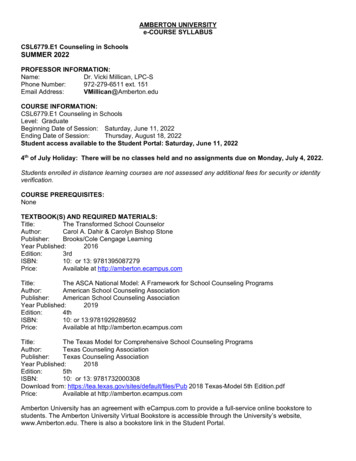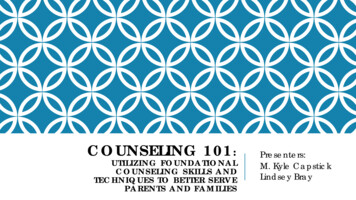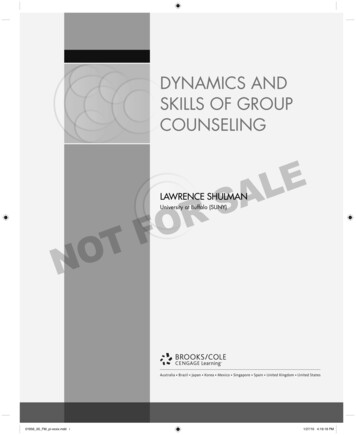
Transcription
COUNSELING SKILLS AND TECHNIQUES8. FAMILY COUNSELING8.1. Introduction to Family TherapyFamily therapy, also referred to as couple and family therapy, marriage and familytherapy, family systems therapy, and family counseling, is a branch ofpsychotherapy that works with families and couples in intimate relationships tonurture change and development. It tends to view change in terms of the systems ofinteraction between family members. It emphasizes family relationships as animportant factor in psychological health. The different schools of family therapyhave in common a belief that, regardless of the origin of the problem, andregardless of whether the clients consider it an individual or family issue, involvingfamilies in solutions often benefits clients. This involvement of families iscommonly accomplished by their direct participation in the therapy session. Theskills of the family therapist thus include the ability to influence conversations in away that catalyzes the strengths, wisdom, and support of the wider system.In the field's early years, many clinicians defined the family in a narrow, traditionalmanner usually including parents and children. As the field has evolved, theconcept of the family is more commonly defined in terms of strongly supportive,long-term roles and relationships between people who may or may not be relatedby blood or marriage. The conceptual frameworks developed by family therapists,especially those of family systems theorists, have been applied to a wide range ofhuman behavior, including organizational dynamics and the study of greatness.Since issues of interpersonal conflict, power, control, values, and ethics are oftenmore pronounced in relationship therapy than in individual therapy, there has beendebate within the profession about the different values that are implicit in thevarious theoretical models of therapy and the role of the therapist’s own values inthe therapeutic process, and how prospective clients should best go about finding atherapist whose values and objectives are most consistent with their own. Specificissues that have emerged have included an increasing questioning of thelongstanding notion of therapeutic neutrality, a concern with questions of justiceand self-determination, connectedness and independence, functioning versusauthenticity, and questions about the degree of the therapist’s pro-marriage/familyversus pro-individual commitment. The American Association for Marriage and1
Family Therapy requires members to adhere to a Code of Ethics, including acommitment to continue therapeutic relationships only so long as it is reasonablyclear that clients are benefiting from the relationship.8.2. History and Theoretical FrameworksFormal interventions with families to help individuals and families experiencingvarious kinds of problems have been a part of many cultures, probably throughouthistory. These interventions have sometimes involved formal procedures or rituals,and often included the extended family as well as non-kin members of thecommunity. Following the emergence of specialization in various societies, theseinterventions were often conducted by particular members of a community forexample, a chief, priest, physician, and so on usually as an ancillary function.Family therapy as a distinct professional practice within Western cultures can beargued to have had its origins in the social work movements of the 19th century inthe United Kingdom and the United States. As a branch of psychotherapy, its rootscan be traced somewhat later to the early 20th century with the emergence of thechild guidance movement and marriage counseling. The formal development offamily therapy dates to the 1940s and early 1950s with the founding in 1942 of theAmerican Association of Marriage Counselors (the precursor of the AAMFT), andthrough the work of various independent clinicians and groups, in the UnitedKingdom, the United States, and Hungary who began seeing family memberstogether for observation or therapy sessions. There was initially a strong influencefrom psychoanalysis (most of the early founders of the field had psychoanalyticbackgrounds) and social psychiatry, and later from learning theory and behaviortherapy and significantly, these clinicians began to articulate various theories aboutthe nature and functioning of the family as an entity that was more than a mereaggregation of individuals.The movement received an important boost starting in the early 1950s through thework of anthropologist Gregory Bateson and colleagues at Palo Alto in the UnitedStates, who introduced ideas from cybernetics and general systems theory intosocial psychology and psychotherapy, focusing in particular on the role ofcommunication. This approach eschewed the traditional focus on individualpsychology and historical factors that involve so-called linear causation andcontent and emphasized instead feedback and homeostatic mechanisms and rulesin here-and-now interactions, so-called circular causation and process that werethought to maintain or exacerbate problems, whatever the original cause(s). This2
group was also influenced significantly by the work of US psychiatrist,hypnotherapist, and brief therapist, Milton H. Erickson, especially his innovativeuse of strategies for change, such as paradoxical directives. The members of theBateson Project (like the founders of a number of other schools of family therapy,including Carl Whitaker, Murray Bowen, and Ivan Böszörményi-Nagy) had aparticular interest in the possible psychosocial causes and treatment ofschizophrenia, especially in terms of the putative meaning and function of signsand symptoms within the family system. The research of psychiatrists andpsychoanalysts Lyman Wynne and Theodore Lidz on communication deviance androles (e.g., pseudo-mutuality, pseudo-hostility, schism and skew) in families ofschizophrenics also became influential with systems-communications-orientedtheorists and therapists. A related theme, applying to dysfunction andpsychopathology more generally, was that of the identified patient or presentingproblem as a manifestation of or surrogate for the family's, or even society's,problems.By the mid-1960s, a number of distinct schools of family therapy had emerged.From those groups that were most strongly influenced by cybernetics and systemstheory, there came MRI Brief Therapy, and slightly later, strategic therapy,Salvador Minuchin's Structural Family Therapy and the Milan systems model.Partly in reaction to some aspects of these systemic models, came the experientialapproaches of Virginia Satir and Carl Whitaker, which downplayed theoreticalconstructs, and emphasized subjective experience and unexpressed feelings(including the subconscious), authentic communication, spontaneity, creativity,total therapist engagement, and often included the extended family. Concurrentlyand somewhat independently, there emerged the various intergenerational therapieswhich present different theories about the intergenerational transmission of healthand dysfunction, but which all deal usually with at least three generations of afamily (in person or conceptually), either directly in therapy sessions, or viahomework, journeys home, etc. Psychodynamic family therapy which, more thanany other school of family therapy, deals directly with individual psychology andthe unconscious in the context of current relationships continued to developthrough a number of groups that were influenced by the ideas and methods ofNathan Ackerman, and also by the British School of Object Relations and JohnBowlby’s work on attachment. Multiple-family group therapy, a precursor ofpsycho-educational family intervention, emerged, in part, as a pragmaticalternative form of intervention especially as an adjunct to the treatment of seriousmental disorders with a significant biological basis, such as schizophrenia andrepresented something of a conceptual challenge to some of the systemic (and thuspotentially family blaming) paradigms of pathogenesis that were implicit in many3
of the dominant models of family therapy. The late 1960s and early 1970s saw thedevelopment of network therapy and the emergence of behavioral marital therapyrenamed behavioral couples therapy in the 1990s.By the late 1970s, the weight of clinical experience especially in relation to thetreatment of serious mental disorders had led to some revision of a number of theoriginal models and a moderation of some of the earlier stridency and theoreticalpurism. There were the beginnings of a general softening of the strict demarcationsbetween schools, with moves toward rapprochement, integration, and eclecticismalthough there was, nevertheless, some hardening of positions within someschools. These trends were reflected in and influenced by lively debates within thefield and critiques from various sources, including feminism and post-modernism,that reflected in part the cultural and political tenor of the times, and whichforeshadowed the emergence (in the 1980s and 1990s) of the various post-systemsconstructivist and social constructionist approaches. While there was still debatewithin the field about whether, or to what degree, the systemic constructivist andmedical biological paradigms were necessarily antithetical to each other, there wasa growing willingness and tendency on the part of family therapists to work inmultimodal clinical partnerships with other members of the helping and medicalprofessions.From the mid 1980s to the present, the field has been marked by a diversity ofapproaches that partly reflect the original schools, but which also draw on othertheories and methods from individual psychotherapy and elsewhere theseapproaches and sources include: brief therapy, structural therapy, constructivistapproaches (e.g., Milan systems, ), solution-focused therapy, narrative therapy, a range of cognitive andbehavioral approaches, psychodynamic and object relations approaches,attachment and Emotionally Focused Therapy, intergenerational approaches,network therapy, and multi-systemic therapy (MST). Multicultural, intercultural,and integrative approaches are being developed. Many practitioners claim to beeclectic, using techniques from several areas, depending upon their owninclinations and/or the needs of the client(s), and there is a growing movementtoward a single generic family therapy that seeks to incorporate the best of theaccumulated knowledge in the field and which can be adapted to many differentcontexts; however, there are still a significant number of therapists who adheremore or less strictly to a particular, or limited number of, approach(es).Ideas and methods from family therapy have been influential in psychotherapygenerally: a survey of over 2,500 US therapists in 2006 revealed that of the 104
most influential therapists of the previous quarter-century, three were prominentfamily therapists and that the marital and family systems model was the secondmost utilized model after cognitive behavioral therapy.8.3. TechniquesFamily therapy uses a range of counseling and other techniques including: Structural therapy - Looks at the Identifies and Re-Orders the organizationof the family system Strategic therapy - Looks at patterns of interactions between familymembers Systemic/Milan therapy - Focuses on belief systems Narrative Therapy - Restoring of dominant problem-saturated narrative,emphasis on context, separation of the problem from the person Transgenerational Therapy - Transgenerational transmission of unhelpfulpatterns of belief and behavior.The number of sessions depends on the situation, but the average is 5-20 sessions.A family therapist usually meets several members of the family at the same time.This has the advantage of making differences between the ways family membersperceive mutual relations as well as interaction patterns in the session apparentboth for the therapist and the family. These patterns frequently mirror habitualinteraction patterns at home, even though the therapist is now incorporated into thefamily system. Therapy interventions usually focus on relationship patterns ratherthan on analyzing impulses of the unconscious mind or early childhood trauma ofindividuals as a Freudian therapist would do, although some schools of familytherapy, for example psychodynamic and intergenerational, do consider suchindividual and historical factors (thus embracing both linear and circular causation)and they may use instruments such as the genogram to help to elucidate thepatterns of relationship across generations.The distinctive feature of family therapy is its perspective and analyticalframework rather than the number of people present at a therapy session.Specifically, family therapists are relational therapists: They are generally moreinterested in what goes on between individuals rather than within one or moreindividuals, although some family therapists, in particular those who identify aspsychodynamic, object relations, intergenerational, or experiential familytherapists (EFTs) tend to be as interested in individuals as in the systems those5
individuals and their relationships constitute. Depending on the conflicts at issueand the progress of therapy to date, a therapist may focus on analyzing specificprevious instances of conflict, as by reviewing a past incident and suggestingalternative ways family members might have responded to one another during it, orinstead proceed directly to addressing the sources of conflict at a more abstractlevel, as by pointing out patterns of interaction that the family might have notnoticed.Family therapists tend to be more interested in the maintenance and/or solving ofproblems rather than in trying to identify a single cause. Some families mayperceive cause-effect analyses as attempts to allocate blame to one or moreindividuals, with the effect that for many families a focus on causation is of little orno clinical utility. It is important to note that a circular way of problem evaluationis used as opposed to a linear route. Using this method, families can be helped byfinding patterns of behavior, what the causes are, and what can be done to bettertheir situation.8.4. LicensingFamily therapy practitioners come from a range of professional backgrounds, andsome are specifically qualified or licensed/registered in family therapy (licensing isnot required in some jurisdictions and requirements vary from place to place). Inthe United Kingdom, family therapists will have a prior relevant professionaltraining in one of the helping professions usually psychologists, psychotherapists,or counselors who have done further training in family therapy, either a diploma oran M.Sc. In the United States there is a specific degree and license as a Marriageand Family therapist, however, psychologists, nurses, psychotherapists, socialworkers, or counselors, and other licensed mental health professionals maypractice family therapy. In the UK, family therapists who have completed a fouryear qualifying program of study (MSc) are eligible to register with theprofessional body the Association of Family Therapy (AFT), and with the UKCouncil for Psychotherapy (UKCP).A master's degree is required to work as an MFT in some American states. Mostcommonly, MFTs will first earn a M.S. or M.A. degree in marriage and familytherapy, psychology, family studies, or social work. After graduation, prospectiveMFTs work as interns under the supervision of a licensed professional and arereferred to as an MFTi. Prior to 1999 in California, counselors who specialized inthis area were called Marriage, Family and Child Counselors. Today, they are6
known as Marriage and Family Therapists (MFT), and work variously in privatepractice, in clinical settings such as hospitals, institutions, or counselingorganizations.Marriage and family therapists in the United States and Canada often seek degreesfrom accredited Masters or Doctoral programs recognized by the Commission onAccreditation for Marriage and Family Therapy Education(COAMFTE), a divisionof the American Association of Marriage and Family Therapy. For accreditedprograms, click here. Requirements vary, but in most states about 3,000 hours ofsupervised work as an intern are needed to sit for a licensing exam. MFTs must belicensed by the state to practice. Only after completing their education andinternship and passing the state licensing exam can a person call themselves aMarital and Family Therapist and work unsupervised. License restrictions can varyconsiderably from state to state. Contact information about licensing boards in theUnited States are provided by the Association of Marital and Family RegulatoryBoards. There have been concerns raised within the profession about the fact thatspecialist training in couples therapy, as distinct from family therapy in general isnot required to gain a license as an MFT or membership of the main professionalbody, the AAMFT.7
family therapists and that the marital and family systems model was the second most utilized model after cognitive behavioral therapy. 8.3. Techniques Family therapy uses a range of counseling and other techniques including: Structural therapy - Looks at the Identifies and Re-Orders the organization of the family system
